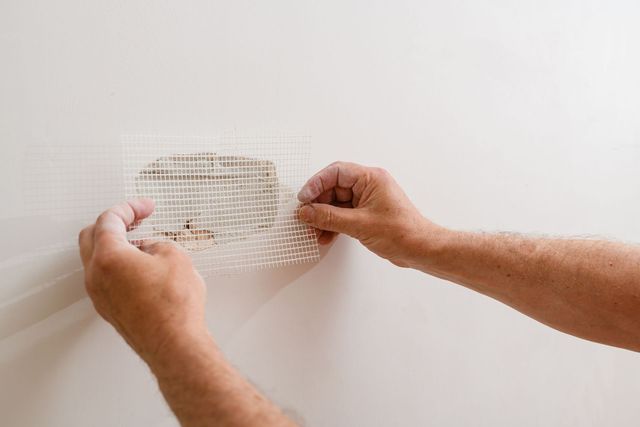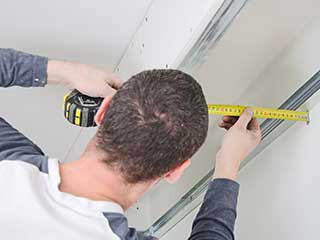Drywall Repair Ogden UT offers reliable services that complement Interior Painting.
Wiki Article
Important Tips for Effective Drywall Repair Work and Installment Techniques
Reliable drywall repair work and setup needs a mindful method. Comprehending the sorts of drywall and having the right tools is crucial. Exact measurements and correct techniques can greatly influence the outcome. Lots of ignore important steps like taping and sanding, which can make or damage the last appearance. As jobs proceed, typical challenges might occur that require interest. Discovering these suggestions can result in a much more effective and refined coating.Understanding Various Sorts Of Drywall
Understanding the different kinds of drywall is crucial for any successful repair work or setup job. Drywall, generally recognized as plaster board, comes in numerous ranges customized for specific applications. Requirement drywall is the most widely made use of type, suitable for general indoor walls and ceilings. Moisture-resistant drywall, usually green in color, is made for areas prone to humidity, such as cooking areas and washrooms. Fire-resistant drywall, generally colored pink or purple, is crafted to hold up against higher temperature levels and is usually utilized in garages or near heating systems. Additionally, soundproof drywall aids reduce noise transmission, making it appropriate for multi-family homes or taping studios. Specialized drywall, like concrete board, is utilized in damp locations like showers or bathtub surrounds. Comprehending these kinds aids in picking the best product for each task, making sure longevity and efficiency in repairs or new installations.Vital Tools for Drywall Repair Service and Setup
Having the right tools is necessary for effective drywall fixing and installation. A quality energy blade is vital for cutting drywall sheets specifically. A drywall T-square helps assure straight sides, while a taping blade is needed for applying joint compound efficiently over seams. Furthermore, a drywall saw permits eliminating harmed sections or suitable drywall around fixtures.For hanging drywall, a power drill with drywall screws is crucial, as it makes it possible for secure and fast installation. A degree is also vital to confirm that the drywall is straight and properly straightened. A sanding block or pole sander is crucial for raveling joint substance once it has actually dried. Ultimately, a determining tape is critical for accurate measurements, avoiding waste and making sure a correct fit. Equipped with these tools, individuals can tackle drywall projects successfully, resulting in professional-looking outcomes.
Step-by-Step Guide to Repairing Holes and Cracks
When addressing holes and splits in drywall, having the right devices and products is crucial for a successful repair service. This guide lays out the needed things and gives a clear, step-by-step procedure to effectively restore the surface area. Understanding these components will certainly help assure a smooth finish and long-lasting results.Devices and Products Needed
A fully equipped toolkit is essential for efficient drywall repair and installation. Key tools include an energy blade for reducing drywall, a measuring tape to assure precise sizing, and a drywall saw for larger openings. A putty knife is important for using joint compound efficiently, while a fining sand block or post sander helps achieve a seamless surface. For patching, a roll of fiberglass mesh tape or paper tape is needed to strengthen joints. Furthermore, a drill and screws are required for protecting new drywall items. Crucial products contain joint substance, guide, and paint to finish the repair service. Having these devices and materials accessible assures a smoother, extra efficient fixing process, producing professional-looking outcomes.Fixing Process Steps
Fixing openings and splits in drywall needs a systematic method to ensure a seamless finish. First, the area surrounding the damage must be cleaned completely to remove dust and debris. Next, for tiny fractures, a putty blade is utilized to use a joint substance equally over the location. For bigger openings, a spot is required; the harmed section is eliminated, and a brand-new piece of drywall is suited location, secured with screws. When the spot remains in setting, joint substance is put on mix the edges. After drying, sanding the area smooth is crucial. The fixed surface must be keyed and repainted to match the surrounding wall surface, ensuring an inconspicuous repair work.Methods for Putting Up Drywall Panels
Setting up drywall panels requires mindful preparation and precise implementation to ensure a smooth and expert finish. It is important to measure the wall surface room accurately and reduce the panels to fit, guaranteeing that they straighten with the studs. Positioning the panels flat is generally advised, as this can boost the architectural stability and decrease the variety of joints.Making use of drywall screws, installers ought to secure the panels every 16 inches along the studs, ensuring a firm hold. It is important to stay clear of overdriving the screws, which can damage the paper surface. For corners and sides, utilizing more tips here an utility blade allows for clean cuts and a tight fit.

Completing Touches: Insulation, Mudding, and Fining sand
When the drywall panels are safely in position, the following essential action entails the finishing touches of taping, mudding, and sanding. Taping is very important for producing a smooth change between panels and concealing joints. A quality drywall tape, either paper or fiberglass harmonize, must be used over the joints, guaranteeing it adheres effectively to the mud that will be used next.Mudding, or using joint substance, follows the taping procedure. This compound fills up spaces and smooths out the surface. An initial layer must be used generously, feathering the edges to blend with the drywall. After the initial layer dries out, succeeding layers may be required for a flawless surface.
Sanding is essential to accomplish a smooth surface area. A fine-grit sandpaper must be used to carefully ravel any type of blemishes. Treatment should be required to avoid over-sanding, which can harm the drywall - Interior Painting. Appropriately carried out, these ending up touches develop a professional appearance all set for painting
Tips for Maintaining Your Drywall After Installation
Preserving drywall after installation is vital to protecting its look and structural honesty. Regular cleansing is essential; dirt and dust can accumulate, so gentle wiping with a wet fabric is suggested. Home owners should likewise evaluate for any indications of moisture or mold and mildew, especially in high-humidity locations like washrooms and kitchens. If any kind of damage takes place, it is essential to address it immediately to stop further problems.Utilizing furnishings pads can assist avoid scratches or damages from hefty things. Additionally, painting the drywall with a top quality, washable paint gives an added layer of defense and makes future cleaning easier. Stay clear of utilizing abrasive cleaners or tools, as these can harm the surface. Maintaining a steady interior environment with proper moisture levels will certainly help stop breaking or contorting over click site time. By following these suggestions, one can assure that drywall continues to be in outstanding problem for several years ahead.
Often Asked Inquiries
The Length Of Time Does Drywall Take to Fully Dry After Installment?

Can I Set Up Drywall Over Existing Drywall?
Yes, drywall can be set up over existing drywall, but it is necessary to assure the underlying surface is safe and secure and effectively prepared. This method can enhance insulation and decrease installation time, though it may include weight.What Is the Finest Method to Soundproof Drywall?
The most effective method to soundproof drywall involves utilizing specialized soundproofing materials, such as resilient networks, acoustic caulk, and sound-dampening drywall. These methods properly lessen sound transmission between spaces, enhancing overall acoustic performance in living rooms.How Do I Choose the Right Drywall Density?
To pick the ideal drywall thickness, take into consideration the application and area. Requirement property wall surfaces typically make use of 1/2 inch, while ceilings or specialized locations might need 5/8 inch for added strength and soundproofing abilities.Exist Eco-Friendly Drywall Options Available?
Yes, environmentally friendly drywall choices are readily available. These consist of products made from recycled materials, plaster boards with low volatile organic substances (VOCs), and those using sustainable manufacturing procedures, offering environmentally-conscious selections for building and improvement jobs.Having the right devices is essential for effective drywall fixing and installment. For hanging drywall, a power drill with drywall screws is indispensable, as it enables fast find more info and safe setup. Secret tools consist of an energy knife for cutting drywall, a tape procedure to ensure precise sizing, and a drywall saw for larger openings. Yes, drywall can be mounted over existing drywall, but it is essential to assure the underlying surface is secure and appropriately prepared. The best method to soundproof drywall entails using specialized soundproofing materials, such as resilient networks, acoustic caulk, and sound-dampening drywall.
Report this wiki page